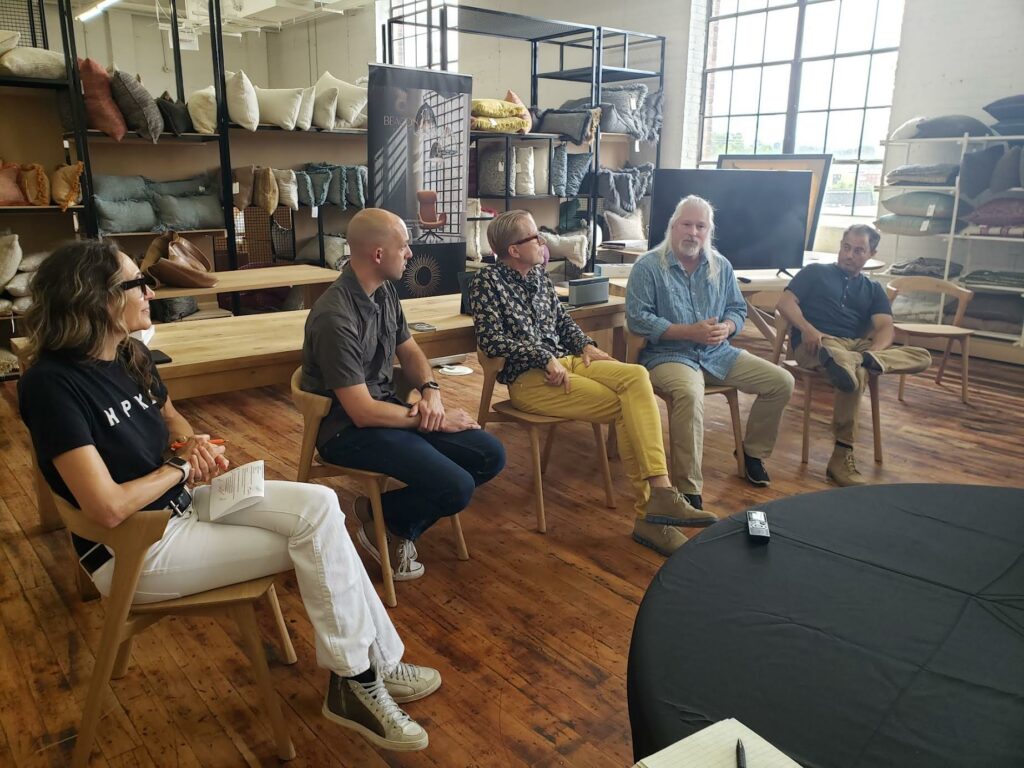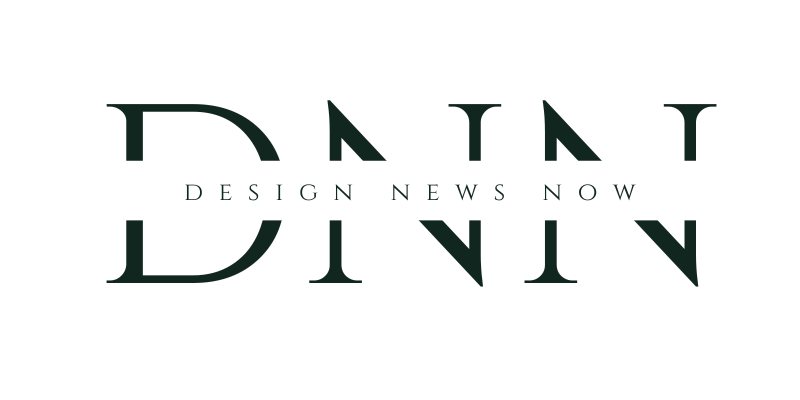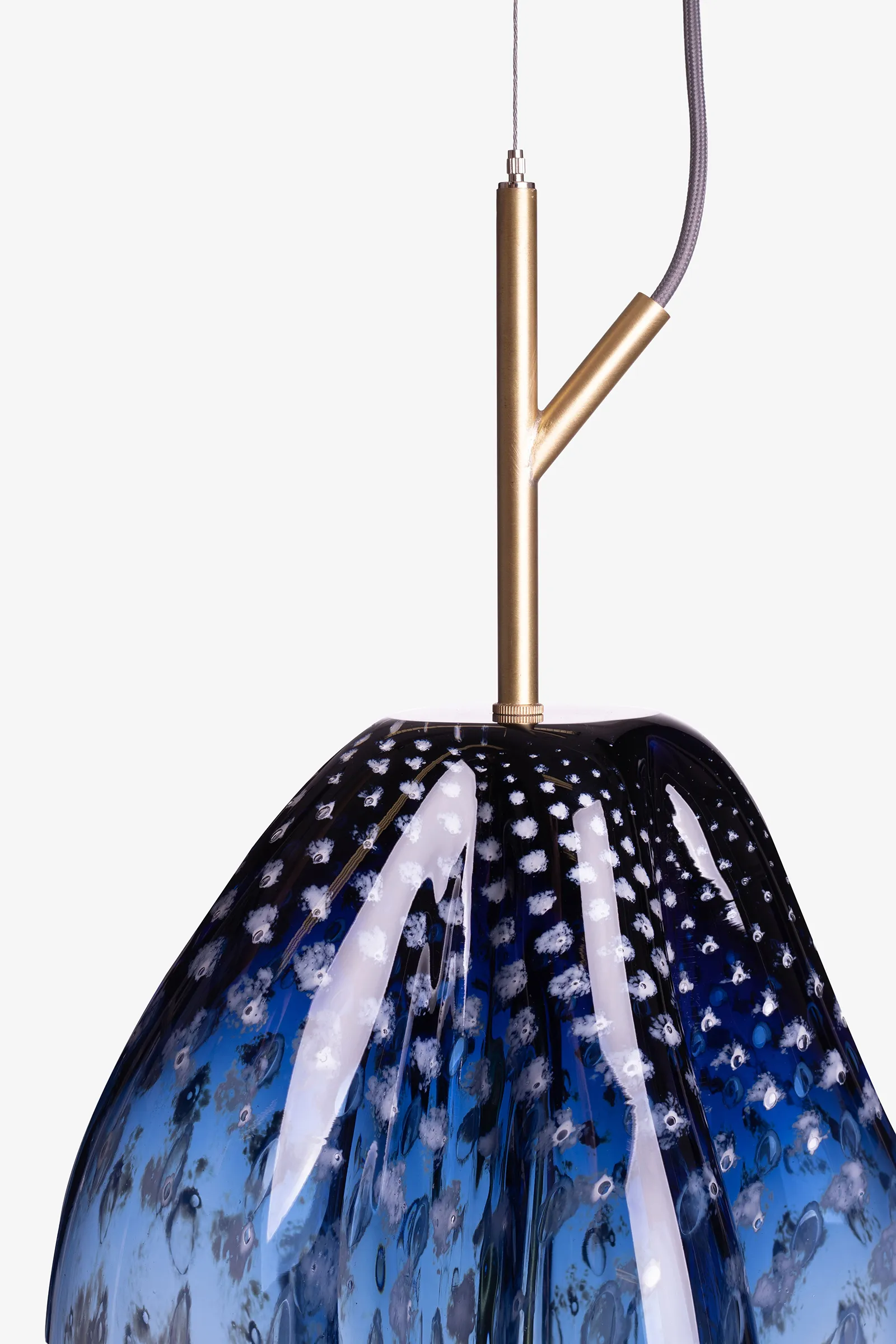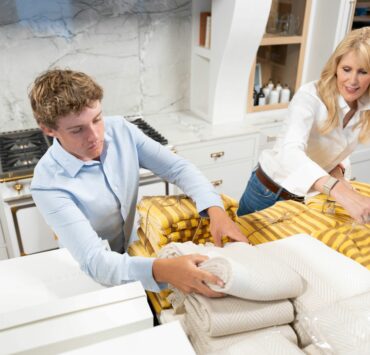Expecting custom products to cost less than stock items. Asking makers to copy the work of others. Not taking advantage of the expertise and capabilities of custom manufacturers.
Producers of custom home furnishings say those are some of the mistakes that interior designers — even experienced, successful ones — make when coming to them for unique items.
With that in mind, High Point x Design hosted a Design Day on June 5 that focused on customization, including the “Shop Talk: Demystifying Custom” workshop. The panel discussion featured Stuart Gans, co-owner of M2C Studio, a custom lighting source that also offers window hardware and other accessories; Frank Leyon, principal and owner of Beacon Custom Lighting, which specializes in glass and metal lighting for residential, commercial and hospitality projects; Hal Mortensen, managing director of Splashworks, an art reproduction, graphic design and printing studio with a growing business in acoustic tiles; and Justin Stabb, owner of Stabb Designs, a digital design, fabrication and installation firm.

The event was held at The Lab HP, a collaborative production space for home furnishings manufacturers and creative brands in High Point owned by Gans and his wife, Leyla Gans. The panel was moderated by Jane Dagmi, managing director of HPxD, which hosts events and facilitates collaborations that bring interior designers and others to High Point throughout the year.
Even if you’ve incorporated custom home furnishings into your projects for years, the panel’s tips may make your next time go more smoothly. And if you’ve just started to dabble in custom furnishings, their guidelines will save you time and hassles.
Some of their tips might feel familiar: They apply to the way interior designers work with clients, too.
* Don’t expect to pay less. Dagmi told the audience that the panel discussion was inspired by a conversation she and Stabb had about a group of high-end designers who were interested in creating a line but who were “very price conscious about it.” The experience highlighted that designers don’t always understand that, by its very nature, custom work will be more expensive than stock retail or even wholesale products. For each unique product, there are one-off designs, molds, prototypes, materials purchases. It all adds up.
“A lot of times I have just one shot at making something (for a custom project),” Stabb said, explaining that for a recent project, he purchased $3,000 worth of brass that he had one opportunity to fabricate, leaving no room for errors.
Leyon told the story of a designer who approached him about making a product similar to one already on the market: “I said, ‘I want to be honest with you. You can buy it from me. I’d love to sell it to you, but if you buy it from me, it will be X amount more.’”
That said, there are ways to bring down the price of custom work, such as modifying the colorway, materials or other details of an existing piece rather than creating an original item that requires new CAD drawings or molds.
For instance, Gans said, changing the diameter of one of his company’s large-scale lighting fixtures by even an inch or two can be costly because it requires, among other things, new molds. Changing the length of the company’s iconic fringe is much easier and still provides a custom look.
“Good suppliers are not just driving up the cost to make more money. What’s driving cost is the amount of work that’s involved,” Gans said.
* Know your budget. That’s one of the first questions a custom manufacturer will ask, the panel members said, and it helps them to know a couple of things: Is it a product they can conceivably manufacture for you? Are you serious and realistic about the project?
With a budget in mind from the start, custom producers are better able to offer you options regarding constructions, components and finishes.
“I’ve learned not to worry and not to feel bad about asking and talking about money,” Stabb said. “… The quicker we know what the budget is, the faster that we’re able to know the validity of the project and the faster we’re able to know what kind of materials and strategy we can use going forward.”
Custom manufacturers typically require 50% of the cost at the start of the project, either when a contract is signed or when an initial design is accepted, and then 50% after delivery or installation. Stabb said he operates differently, requiring 30% when the contract is signed, 30% when a design is approved, 30% after production and 10% after installation, which he always does himself. Stabb landed on the pricing structure after having too many prospective clients take his initial designs and give them to other manufacturers to produce.
“I would venture to say, most designers can’t afford us,” Leyon said, adding an important caveat: “Most designers can’t afford truly custom but sophisticated clients don’t want what everybody else has.” And those clients will see the value of proprietary designs and custom manufacturing capabilities, he said.
* Don’t ask producers to be copycats. This seems obvious but everyone on the panel said they are regularly asked to reproduce someone else’s work. Leyon estimated that 50% of the requests he receives from prospective customers ask him to copy an existing design — “and the answer is a hard no,” he told the audience. Mortensen agreed, saying about half of the customers who approach Splashworks to reproduce a piece of artwork don’t own the copyright to it.
The panelists decline such requests for a number of reasons, starting with the fact that it’s unethical — and, if the design has been trademarked or copyrighted, it’s illegal. They also get frustrated seeing their own work copied by others and don’t want to perpetuate that cycle.
“I will say to a designer (who wants a copycat product), ‘If this is your general idea, why don’t you go back and sketch something along those lines that you like and then we can rework it and make a propriety version of what inspired your vision,” Leyon said. Of course, some vintage pieces and antiques have never been trademarked or are now in the public domain. Custom manufacturers have more leeway to produce new products based on such designs.
* Form real relationships with manufacturers. By doing so, you’ll better understand their capabilities — and they’ll be more willing to work you into their production schedule, try something new for you, or hop on a call with you and your client to answer questions, consider options or discuss installation.
Stabb often offers to meet with his customers’ clients to discuss projects: “And I always have a conversation with a designer ahead of time: ‘How do we navigate this conversation? Are there any pain points with the client? Are there any things that we need to stay away or anything I should hit on during this pitch to really help?’”
* Rely on a custom maker’s expertise. You’re not just paying for a custom product, you’re paying for the company’s knowledge and experience, too. “Often what I’m designing doesn’t necessarily already exist,” Stabb said. “Designers often come to me when they’ve exhausted all their other resources.”
Gans encouraged interior designers to “really listen to (custom manufacturers) and be open to working together. Use it as a journey because any good supplier is going to guide you in the right way to make it work.”
Mortensen shared the story of a “ginormous” project that involved creating 1,500 acoustic panels in a variety of shapes. The Splashworks team knew it would be a nightmare to install directly on the walls and worked with Stabb to hang the individual acoustic panels on a custom-made system of panels that clip together. “It did increase the budget because we had to design the system and mechanism from scratch, but the client found it was also going to save them significantly on installation,” Mortensen said.
* Embrace the stories. One of the key selling points of custom products is that they give your clients a story to tell their friends, family and guests. They can talk about the artisans who created the piece, the origins of the materials and components, the challenges of getting the item installed in their home. And clients love doing that, the panelists said.
“Designers come into our shop and get excited and say, ‘Gosh, the wood for your frames is milled 20 miles from here and the fabric is woven here (in High Point),’” Mortensen said. “They know the story as well as we know the story and then they communicate it to their clients. By being hands on and visiting the custom houses you’re dealing with, you’ll see the stories pretty quick. And as you get excited about it, your clients will get excited.”




